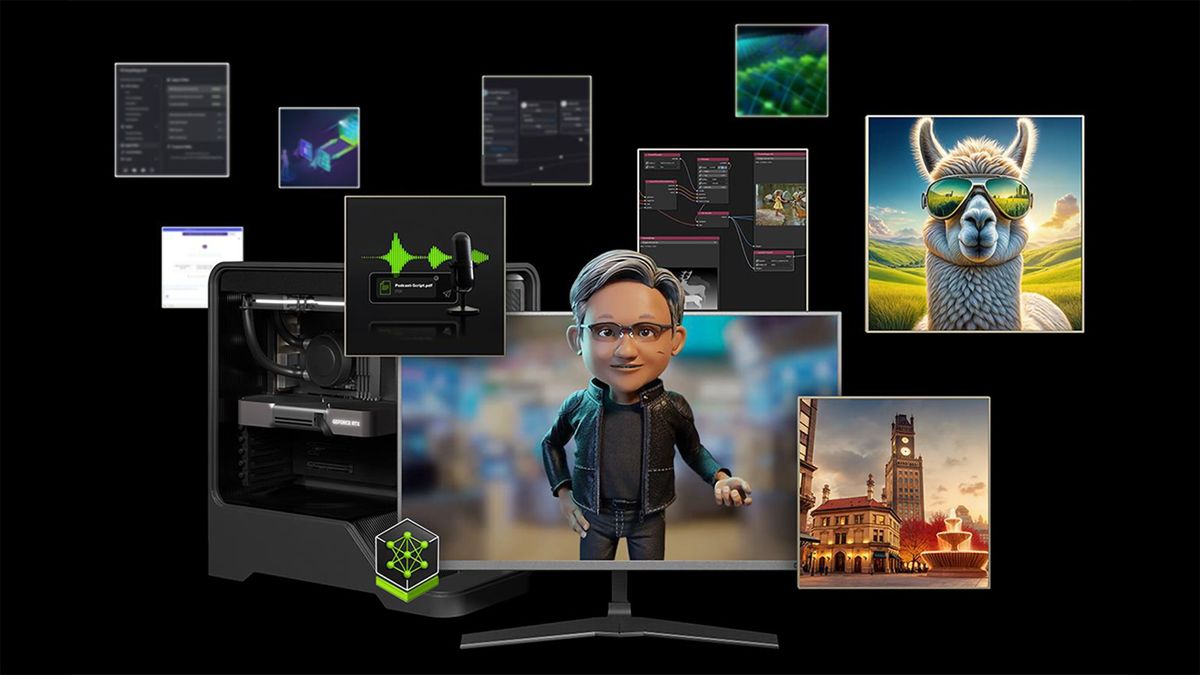Let's Master AI Together!
Nvidia RTX AI PCs and Generative AI: Revolutionizing Work and Play
Written by: Chris Porter / AIwithChris

Image Source: NVIDIA
Evolving Technology: Nvidia's Bold Move into AI
The gaming and professional landscape has never been as exciting as it is today, with companies like NVIDIA pushing the boundaries of what's possible with their latest innovations. By introducing RTX AI PCs powered by the groundbreaking Blackwell GPU architecture, NVIDIA is set to change both how we work and how we play. The newest member of their product family, the GeForce RTX 50-series, which includes the ultra-fast GeForce RTX 5090, is specifically designed to elevate the user experience to unprecedented heights.
The RTX 50-series GPUs feature advanced technologies such as fifth-generation Tensor Cores and fourth-generation RT Cores. These components are crucial for enabling AI-driven rendering capabilities along with neural shaders that can significantly enhance the realism and interactive experience in games. This transformer effect is not limited to just gaming; it extends to many other domains, including content creation and digital artistry, amplified by the computational prowess of the GPUs.
A key aspect of the Blackwell architecture is its optimization for neural workloads, making it possible to tackle demanding tasks while keeping the memory footprint low and energy efficiency high. This is a game changer. By making AI more accessible and practical on consumer-grade hardware, NVIDIA is paving the way for creators and enthusiasts to harness AI tools without the need for complex infrastructures.
Generative AI in Gaming: A New Paradigm
Generative AI has become an increasingly influential force in various fields, particularly in gaming, where it can reshape the underlying processes of game development. Thanks to the RTX 50-series GPUs, users can now run generative AI models at home, effectively democratizing what was once reserved for industry professionals. With tools like NVIDIA AI Blueprints—comprised of NIM microservices—developers are presented with preconfigured workflows, providing an easy pathway to complex applications, such as creating lifelike digital humans.
This accessibility is a matter of great significance as it allows aspiring developers to interact with the latest generative AI models without a steep learning curve. The incorporation of simple graphical user interfaces means that even those without substantial technical backgrounds can experiment and innovate within this exciting frontier of technology. Each AI Blueprint serves as a gateway to a host of possibilities, ranging from the creation of hyper-realistic game avatars to dynamic environmental interactions.
One of the standout features of the NVIDIA RTX PCs is their support for FP4 compute. This technological advancement doubles AI inference performance, which is substantial for real-time applications—a significant requirement when it comes to gaming. This gives developers greater flexibility to create complex systems that respond to player actions dynamically, resulting in a significantly enriched gameplay experience.
_edited.png)
🔥 Ready to dive into AI and automation? Start learning today at AIwithChris.com! 🚀Join my community for FREE and get access to exclusive AI tools and learning modules – let's unlock the power of AI together!
Keep reading below...
Transforming Gaming Experiences with NVIDIA's New Technologies
One of the most promising aspects of NVIDIA's foray into AI is the creation of NVIDIA RTX Remix. This innovative feature leverages generative AI to enhance classic game textures, transforming them into stunning, high-resolution visual experiences that attract both nostalgic gamers and newcomers alike. By upgrading older games to 4K-resolution materials, RTX Remix not only rejuvenates the gaming catalog but also fosters a deeper appreciation for the art of game design across generations.
There is also a tangible benefit for developers who are looking to create more engaging stories within their games. The integration of NVIDIA's ACE microservices facilitates the addition of intelligent, animated digital avatars capable of AI-driven speech and animation models. With these enhancements, players can enjoy interactions that feel more authentic, opening doors to more immersive and emotionally resonating experiences.
What’s also worth noting is the crucial role of communities built around these technologies. The advancements in AI lead to collaborative efforts where enthusiasts and professionals share insights, discuss newfound capabilities, and brainstorm innovative uses for the RTX AI PCs. As the lines between player and developer blur, more users can become active creators rather than passive consumers.
The transformation promised by NVIDIA's RTX AI PCs and generative AI is not just a gradual transition; it's evidently a revolution. The ability to incorporate AI tools directly into the PC gaming experience means a substantial shift in how gamers perceive content creation and engagement. This inevitably changes not only the gaming landscape but also the creative landscape at large, prompting fresh ideas and new genres.
Conclusion: Embrace the Future with AI
NVIDIA's RTX AI PCs and generative AI technologies represent a significant step forward in computing power and user accessibility. With the introduction of the Blackwell GPU architecture and the unprecedented capabilities of the RTX 50-series, users now have the tools they need to explore their creativity and engage with their favorite games like never before. As generative AI continues to evolve, so too will the opportunities it presents for gamers and developers alike. If you're looking to dive deeper into this transformative wave of technology and explore the broader applications of AI, visit AIwithChris.com for more engaging insights and information.
